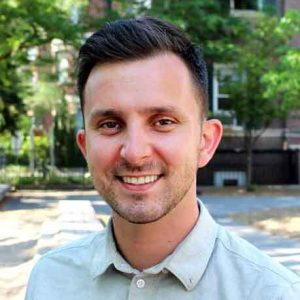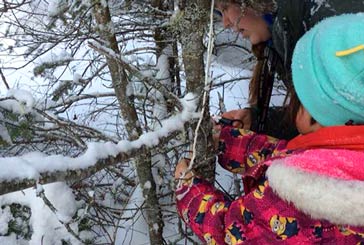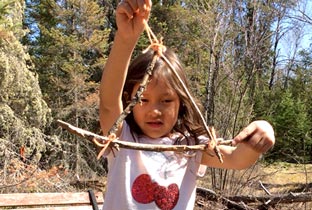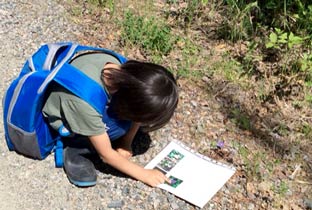Math, science & exploration
in outdoor classrooms
The Rural Outdoor Classroom
New ideas from "Camp" at Mine Centre P.S.
The Urban Outdoor Classroom
Video tours of 2 different outdoor spaces in Toronto
Outdoor Math Lessons
3 lessons that can be used with any class outdoors
The Rural Outdoor Classroom
"Camp" at Mine Centre P.S. includes math, science and Anishinaabe culture
This year, the kindergarten teaching team at Mine Centre Public School is spending more time in their outdoor classroom than ever before. They head outside four times each week – twice during the math block and twice during language.
“When we first started doing all of this, we were only going out once a week for one block of the day,” says Teacher Marge Hale. “But we felt – and actually feel even more strongly now – that students need to be outside more.”
Marge started the outdoor classroom seven years ago with Early Childhood Educator Sara Empey when they recognized that, when outside, their students were motivated by their own curiosity to explore and talk about the world around them when outside. They’ve since created “camp” in the nearby woods, which includes a meeting area with benches, a fire pit, a shelter and looping trails through the surrounding
forest. Their work has been featured in Natural Curiosity, an environmental educational resource with an Indigenous lens, and the team even won an award of recognition from the Rainy River Board of Education.
“When we first started, we had a focus on language and literacy. Now, we use camp for math, science, literacy, language and mental health,” says Marge. “We often have a silent minute before our reading circle to center ourselves. For one minute, we just listen. Then we talk about what we heard – usually birds, wind, leaves moving, traffic and ‘bears’.”
Sara says she believes that camp has a positive influence on the students’ mental health, many whom have been experiencing stress due to Covid-19 in addition to family stress at home.
VIDEO: The Robertson Program visited “Camp” at Mine Centre Public School a few years ago. Kindergarten Teacher Marge Hale gave us a tour of the space and shared stories about some of the learning that her students have engaged in.
“We have students experiencing Covid stress, as well as family stress,” she says. “Going to camp helps. Being in nature provides enough of an experience itself that our students are happy to explore and learn on their own. We don’t need a lot of toys, gadgets or games. Students use what they have at their disposal and make up their own activities, too.”
The third member of the teaching team is Ojibwe language teacher Verna White, who shares Anishinaabe knowledge and stories about the plants, animals and critters encountered during their time in the bush.
“I love to tell the children stories about animal names and teach them to respect the plants and animals and just letting them know that we are visitors in their home when we go to camp,” Verna says. “Wintertime is just around the corner and I can’t wait to tell them stories about how the different animals came to be and about how Nanaboozoo decided he was going to copy Woodpecker because he was hungry and ended up with a broken nose!”
Before heading to camp, the team decides on a focus for the day, along with related activities. They do their best to connect their plan to their current science inquiry or whatever the class is doing in math or literacy.
The group has learned to adapt, though, finding balance between what they’ve planned with what interests the children that day. They keep their planned activity short, making sure they give students lots of time to time to play, hike and explore on their own.
“One day we left for camp intent on looking for cedar, but there was frost on the ground and fog in the air. So, we turned our discussion to that instead!” Sara says. “Sometimes something happens or catches the children’s attention on our way to camp and we just flip our focus. We follow what seems to engage them.”
The Urban Outdoor Classroom
Equinox Outdoor Kindergarten Classroom
Among the homes of a densely populated neighbourhood in Toronto’s East End, you find the kindergarten students at Equinox Alternative School. Outside for at least three hours every day, regardless of weather, the children balance their time between outdoor and indoor exploration. Students engage in a mix of unstructured individual and group free play, play-based learning, and teacher guided/assisted inquiry. Equinox seeks to create a relationship between the children and the natural world around them, both on school grounds and extending into settings such as parks and ravines in the surrounding community.
VIDEO: Educator Heather Lott shows us how her kindergarten students use their outdoor classroom to explore capacity, patterns, life cycles and so much more.
The Dr. Eric Jackman Institute of Child Study Courtyard
Nestled among with tall downtown Toronto apartment buildings and Victorian homes, you find the small, yet thoughtful courtyard at the Dr. Eric Jackman Institute of Child Study (JICS). In what is truly an urban setting, the sound of construction blends with that of birds to create a space where children begin building authentic relationship with the Land.
“This is a place to observe and engage with the seasons,” says Krista Spence, JICS Teacher-Librarian. “Recognizing, naming and knowing about a finite number of plants and creatures is a powerful starting place to learn how we are all connected. This is our living room, our playground, our study. It’s where we pause and connect, watch and wonder.”
VIDEO: Teacher-librarian Krista Spence shows us how the students at the University of Toronto lab school use their courtyard space as a means to make meaningful connection to the land.
Outdoor Math Lessons
Measuring the circumference of a tree
Students use non-standard units of measurement to measure and compare tree circumference.
Finding geometric shapes outside
Sticks and stones can make 2- and 3-dimensional shapes that students can use to explore geometry outdoors.
The plants that live
around us
Students learn about plant species and their characteristics by exploring their natural environment
What’s happening at Camp this year?
ECE Sara Empey on the math, science and literacy at Mine Centre P.S.
“The kindergarten students at Mine Centre Public School have been learning some of the science behind trees, mushrooms and camouflage. For math, they are counting things around camp, forming numbers in mud, making patterns with natural materials, and locating and sequencing numbers the teachers have hung along a trail so the class can sequence them from one to 10. We also continue to hold reading circles and they’re writing a song about how everyone feels about camp.

“One day on our way back to school, we were lucky enough to see a snowshoe hare standing completely still not far off the trail. He thought he was camouflaged, but his feet and ears were still transitioning from brown to white so the class could easily see him,” Sara says. “With this new snowfall, I know the children will be enthralled by the many animal tracks we’re sure to find both on the way to camp and on the trails at camp.”
Animals
“Our class is always on the look for wild animals or any evidence they leave behind.
“Verna is also introducing the class to the Anishinaabe names for animals in local area. She plans on focusing on a new animal each week. So far, the children have learned moonz for moose, makwa for bear, waabooz for rabbit. This week, they will be learning waagosh for fox.”
Balance
“The kids have walked some of the trails in small groups, practicing how to balance on logs, stumps, rocks anything else they could find. During the next visit, they each chose a stick to try to balance on their finger, a branch, a rock, a bench, anything really.
“There was lots of good conversation about the relationship between the shape and size of your stick and the shape and size of what the stick was being balanced on. One group even stuck a stick in the ground so it was standing up and tried balancing a rock on top of the stick.”
Building
“Students are always using pieces of wood to make pretend houses, bridges and ramps. They love to place wooden planks or branches on the ground and hop from one piece to the next.
“We talk about their creations and discuss what they were considering during the construction process. Sometimes we discuss the surface they’re building on to determine whether anything can be improved – and why. Sometimes we talk about stability and count the number of items they’ve used. Then we decide how many we might want to add or take away.”
Trees
“In previous years, each child has selected a tree to observe throughout the year. But this year, we plan on taking a slower, more careful approach. We are introducing the trees we have in the area one at a time. We want to make sure the children can independently find and identify whichever tree is our focus.
“Our first tree this year was cedar. We talked about the tree and then found one in our forest. The children found leaves to bring back to do some leaf rubbings. We watched a video of an elder teaching about cedar and even tasted some cedar tea! We hope to learn the Anishinaabe names and any related teachings for all the trees we explore.”
Sit spot
“This year, we started incorporating ‘sit spots.’ We all sing a song about sit spots and then one of us leads a ‘train’ to drop children off along a trail where they sit or stand quietly and look around and listen. After each child is dropped off at their spot, we run around back to the start of the trail and pick all the kids back up. When the train arrives back at our meeting area, we talk about what they heard and saw around them.
“The children remark on the the leaves rustling in the wind, seeing squirrels or birds, and usually someone claims to hear a bear. One student told us about how he watched a squirrel jump from tree to tree. The class enjoy sit spots because they love any opportunity to share their thoughts with their peers.
“Students can be apprehensive, but that’s okay. One student walked away from her sit spot to go sit on the bench and just watched from the sideline. She joined in the next time, though! Sometimes when we get back together as a group we prompt them with a question to get the conversation started, but other times they just start sharing what they experienced.”
Mud Kitchen
“Year after year, our kids always pretend cook at camp, so we’ve embraced it. Camp has some pretend kitchen items, such as a stove top, oven, sink, pots and pans, but the children use the forest for the rest.
“They love finding things in the forest to make meals for their friends or family. The kids seem to start in the kitchen and after a while, they slowly start moving into other areas to play things like hide and seek.”’
Author

Zach Pedersen
Program Coordinator, The Robertson Program



